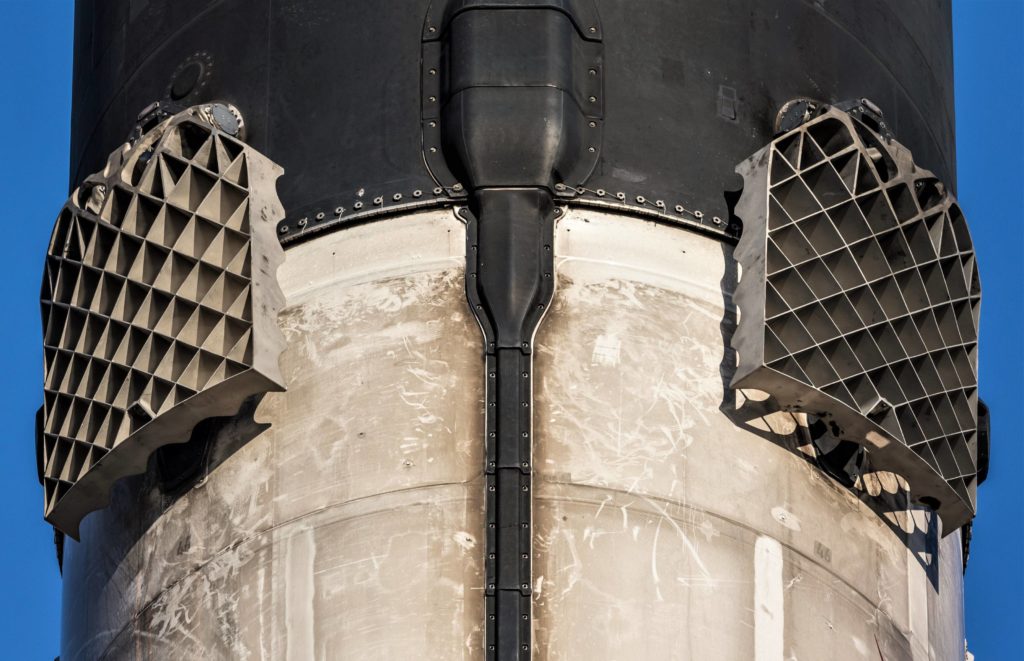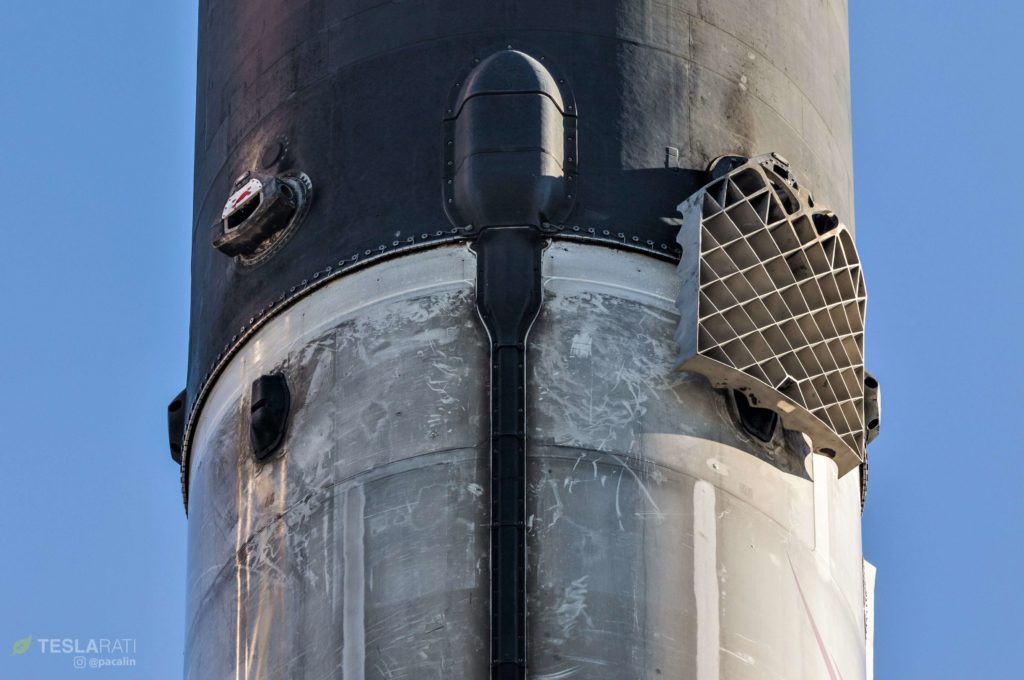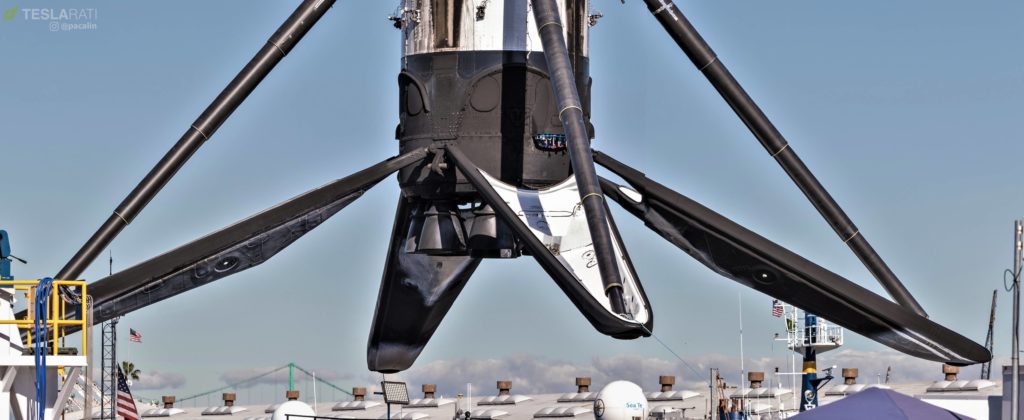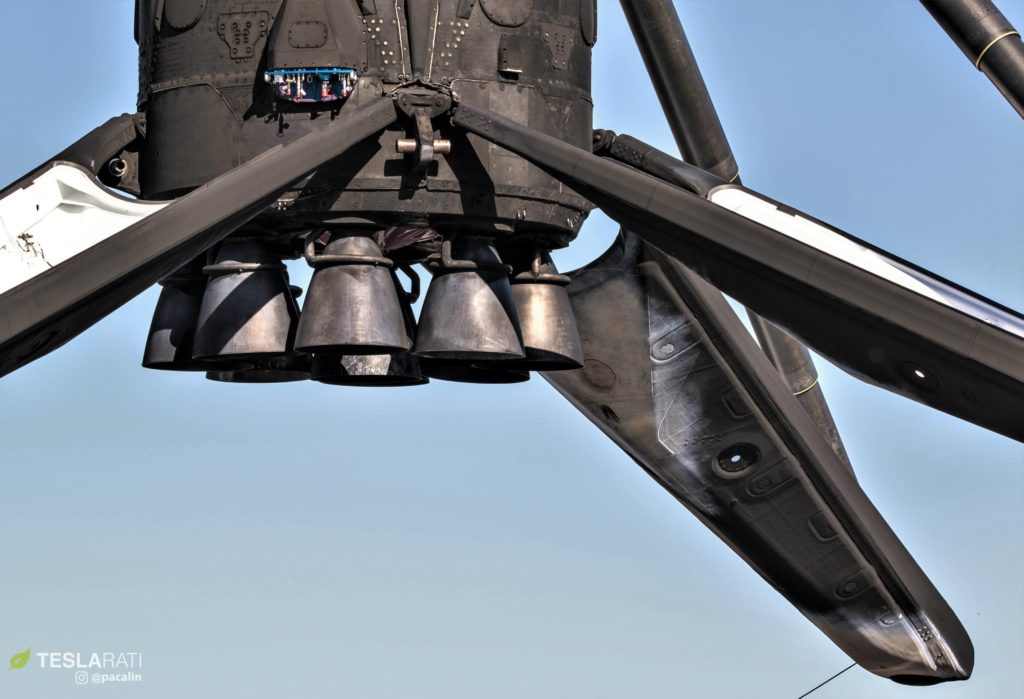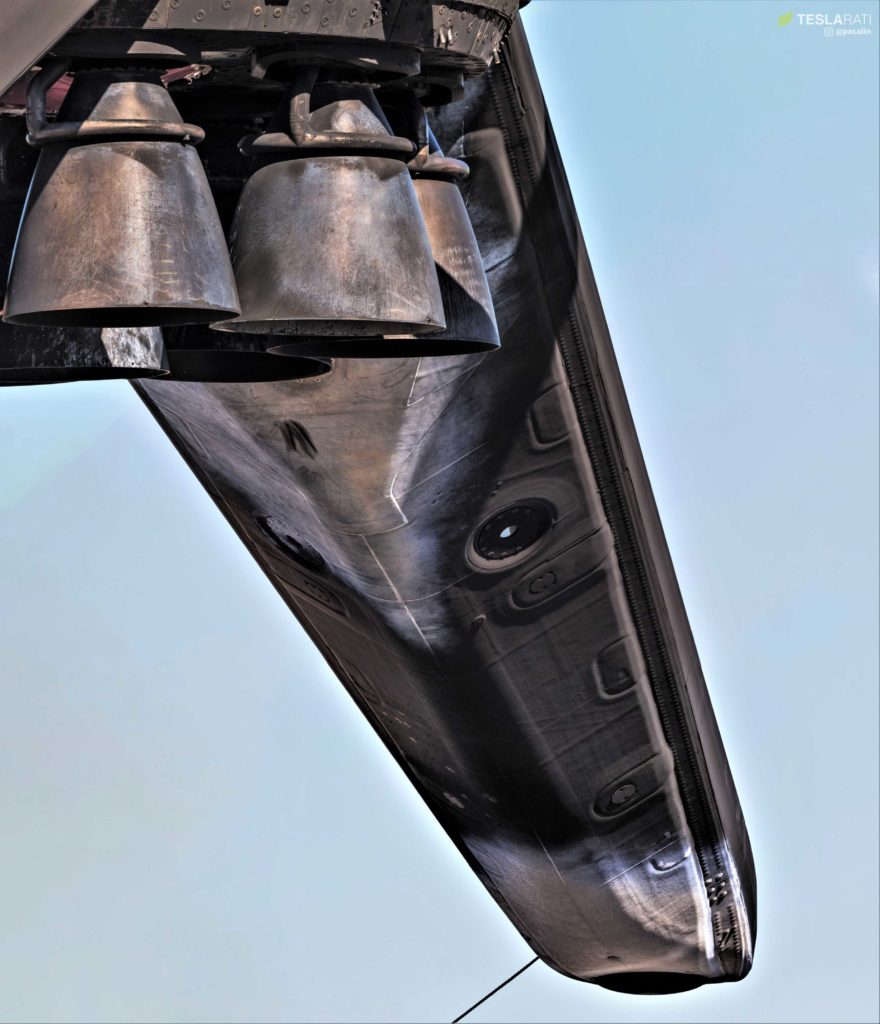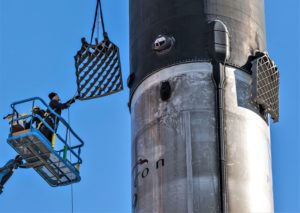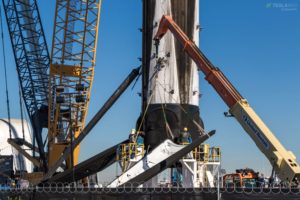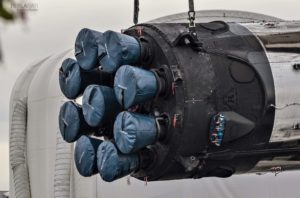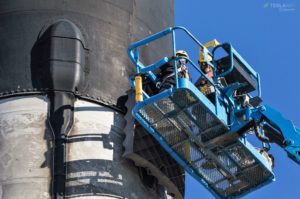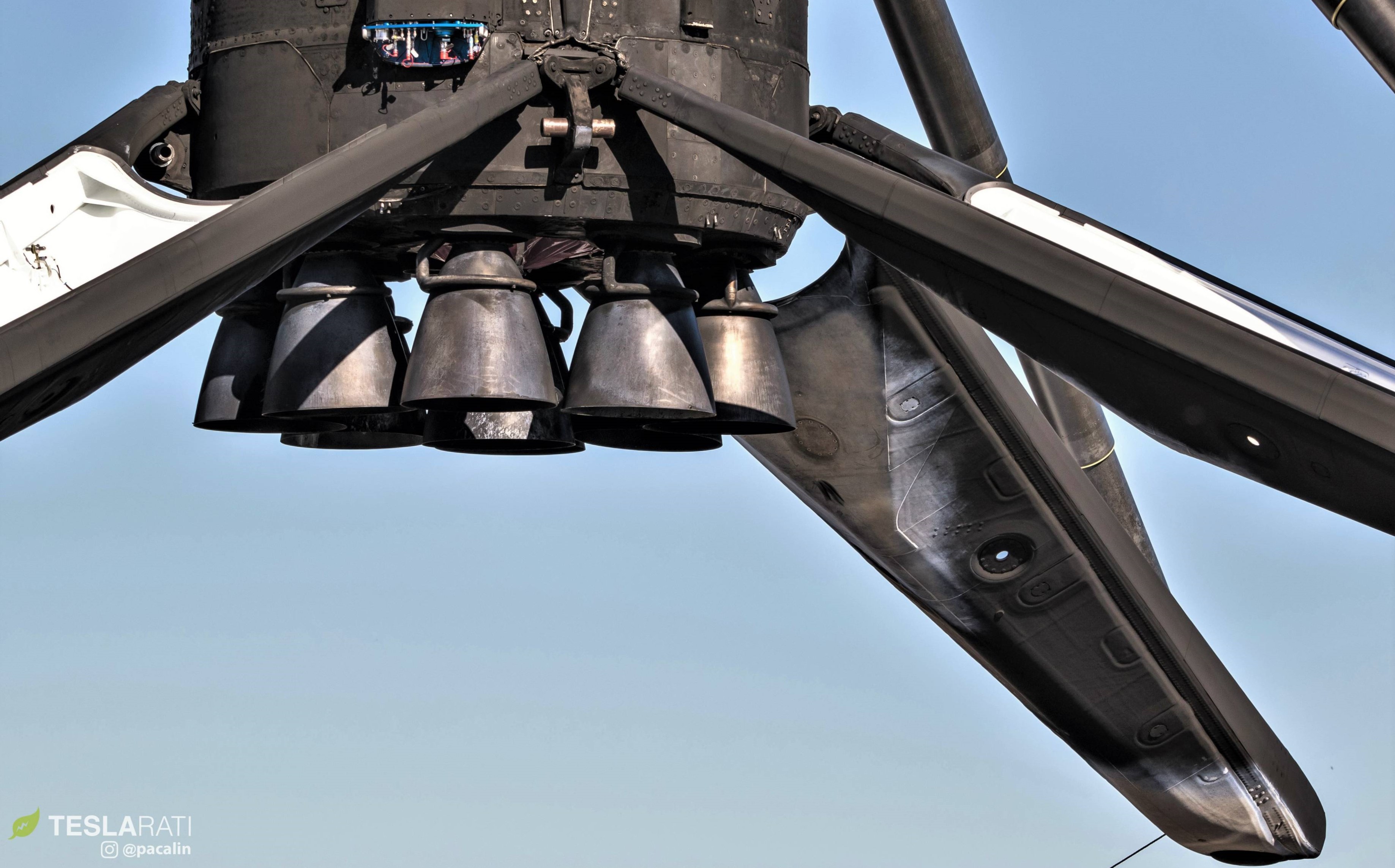

News
SpaceX caps major Falcon 9 Block 5 reuse with spectacular Port of LA recovery
SpaceX has completed what might be its most important Falcon 9 reuse yet after successfully launching and recovering booster B1046 for the third time in just six months. Prior to this launch, the company had never before flown a reused Falcon 9 booster more than once.
Making way for a probable fourth launch in the near future, B1046’s Port of Los Angeles return was marked by a stream of spectacular visuals as seasoned SpaceX recovery technicians transferred the booster from drone ship to land, performed initial inspections, and prepared it for transport back to Hawthorne, where it will undergo (hopefully minimal) refurbishment.
Falcon 9 B1046.3 went horizontal this afternoon after spending 6 days at port of LA. #spacex @Teslarati pic.twitter.com/QqTpMFvl0F
— Pauline Acalin (@w00ki33) December 11, 2018
Displaying inspiring dedication, Teslarati photographer Pauline Acalin managed to stick with B1046 for a major portion of the six days it spent on the docks, despite a rare spate of rainy and downright stormy days in Los Angeles. Her patience was awarded with a number of beautiful photos documenting nearly every significant aspect of any given Falcon 9 booster recovery, ranging from the lift from drone ship to dockside and the removal of all four titanium grid fins to the rocket’s flip from a vertical to a horizontal orientation ahead of road transport back to SpaceX’s Hawthorne factory.
Above all else, the most noteworthy aspect of Falcon 9 B1046’s third return to port is just how unharmed the rocket appears, at least from an external perspective. The booster has grown a fairly healthy triple coating of kerosene soot from its three reentry and landing burns, thick enough that Falcon 9’s mirror-shiny white skin is barely visible on the lower (RP-1) propellant tank. At this point, it seems that SpaceX has concluded that any possible performance loss from those soot layers are small enough to be negligible.
- Falcon 9 B1046 stands proud and sooty after its third successful launch. (Pauline Acalin)
- Goodbye, grid fin! (Pauline Acalin)
- Falcon 9 is lifted from drone ship JRTI to SpaceX’s Port of LA dock space. (Pauline Acalin)
- Shiny(ish)! (Pauline Acalin)
- It’s unclear what exactly causes it, but Falcon 9 Block 5’s newly heat-shielded legs turn a rather bright white after being scorched during booster landings. (Pauline Acalin)
In an operational sense, SpaceX’s Falcon 9 recovery procedures and the technicians that perform the actual task of recovery seem to be approaching the work with an attitude that fits better in the realm of commercial aviation than in what is perceived as modern rocketry (clean rooms, surgical precision, etc.). Both the procedures and technicians seem to have been refined into what now runs like a well-oiled machine, wrapping up the complex and pathfinding task of recovering a thrice-flown Falcon 9 booster in less than a week from its drone ship landing to Hawthorne arrival.
The condition of B1046 could well make or break the future of the Falcon 9 family, as any significant departure from Block 5’s design intentions could cut the operational lifetime of the ~10 boosters already produced by dozens of fleet-wide flights.
- Falcon 9 B1046’s flight-proven titanium grid fins are carefully removed. (Pauline Acalin)
- Legs, too! (Pauline Acalin)
- With any luck, B1046’s nine Merlin 1D engines may well see another orbital-class launch in the near future. (Pauline Acalin)
- Never forget your aerospace-grade pool noodles, kids. (Pauline Acalin)
On the other hand, a rapid and relatively painless post-recovery inspection and a general bill of nominal health could – pending customer comfort and SpaceX pricing it right – open the floodgates for the company’s fleet of (optimally) reusable rocket boosters. Even if it turns on that Falcon 9 Block 5 boosters almost invariably demand $10M+ in extensive refurbishment after every launch and can only manage a max of 10 launches before heading to the scrapyard, SpaceX could quite literally become untouchable on the global launch market and remain so for a minimum of 5+ years.
First grid fin has been removed from the 3x flown Falcon 9 standing at port of LA. Been wanting to see this happen for years. So NEAT! #spacex @Teslarati pic.twitter.com/iICf7Pypn8
— Pauline Acalin (@w00ki33) December 8, 2018
So long as the company can preserve the Falcon family’s impressive and ever-growing heritage of reliability alongside industry-leading reusability, there isn’t a company or country in the world that could beat SpaceX’s business model if it ever came down to a contract competition death-match, so to speak, not for another 5-10 years. It may never come to that, but that capability will – at the bare minimum – give SpaceX a nearly unbeatable upper hand for launching its own global constellation of internet satellites, known as Starlink.
For prompt updates, on-the-ground perspectives, and unique glimpses of SpaceX’s rocket recovery fleet check out our brand new LaunchPad and LandingZone newsletters!
News
Tesla launches in India with Model Y, showing pricing will be biggest challenge
Tesla finally got its Model Y launched in India, but it will surely come at a price for consumers.

Tesla has officially launched in India following years of delays, as it brought its Model Y to the market for the first time on Tuesday.
However, the launch showed that pricing is going to be its biggest challenge. The all-electric Model Y is priced significantly higher than in other major markets in which Tesla operates.
On Tuesday, Tesla’s Model Y went up for sale for 59,89,000 rupees for the Rear-Wheel Drive configuration, while the Long Range Rear-Wheel Drive was priced at 67,89,000.
This equates to $69,686 for the RWD and $78,994 for the Long Range RWD, a substantial markup compared to what these cars sell for in the United States.
🚨 Here’s the difference in price for the Tesla Model Y in the U.S. compared to India.
🚨 59,89,000 is $69,686
🚨 67,89,000 is $78,994 pic.twitter.com/7EUzyWLcED— TESLARATI (@Teslarati) July 15, 2025
Deliveries are currently scheduled for the third quarter, and it will be interesting to see how many units they can sell in the market at this price point.
The price includes tariffs and additional fees that are applied by the Indian government, which has aimed to work with foreign automakers to come to terms on lower duties that increase vehicle cost.
Tesla Model Y seen testing under wraps in India ahead of launch
There is a chance that these duties will be removed, which would create a more stable and affordable pricing model for Tesla in the future. President Trump and Indian Prime Minister Narendra Modi continue to iron out those details.
Maharashtra Chief Minister Devendra Fadnavis said to reporters outside the company’s new outlet in the region (via Reuters):
“In the future, we wish to see R&D and manufacturing done in India, and I am sure at an appropriate stage, Tesla will think about it.”
It appears to be eerily similar to the same “game of chicken” Tesla played with Indian government officials for the past few years. Tesla has always wanted to enter India, but was unable to do so due to these import duties.
India wanted Tesla to commit to building a Gigafactory in the country, but Tesla wanted to test demand first.
It seems this could be that demand test, and the duties are going to have a significant impact on what demand will actually be.
Elon Musk
Tesla ups Robotaxi fare price to another comical figure with service area expansion
Tesla upped its fare price for a Robotaxi ride from $4.20 to, you guessed it, $6.90.

Tesla has upped its fare price for the Robotaxi platform in Austin for the first time since its launch on June 22. The increase came on the same day that Tesla expanded its Service Area for the Robotaxi ride-hailing service, offering rides to a broader portion of the city.
The price is up from $4.20, a figure that many Tesla fans will find amusing, considering CEO Elon Musk has used that number, as well as ’69,’ as a light-hearted attempt at comedy over the past several years.
Musk confirmed yesterday that Tesla would up the price per ride from that $4.20 point to $6.90. Are we really surprised that is what the company decided on, as the expansion of the Service Area also took effect on Monday?
But the price is now a princely $6.90, as foretold in the prophecy 😂
— Elon Musk (@elonmusk) July 14, 2025
The Service Area expansion was also somewhat of a joke too, especially considering the shape of the new region where the driverless service can travel.
I wrote yesterday about how it might be funny, but in reality, it is more of a message to competitors that Tesla can expand in Austin wherever it wants at any time.
Tesla’s Robotaxi expansion wasn’t a joke, it was a warning to competitors
It was only a matter of time before the Robotaxi platform would subject riders to a higher, flat fee for a ride. This is primarily due to two reasons: the size of the access program is increasing, and, more importantly, the service area is expanding in size.
Tesla has already surpassed Waymo in Austin in terms of its service area, which is roughly five square miles larger. Waymo launched driverless rides to the public back in March, while Tesla’s just became available to a small group in June. Tesla has already expanded it, allowing new members to hail a ride from a driverless Model Y nearly every day.
The Robotaxi app is also becoming more robust as Tesla is adding new features with updates. It has already been updated on two occasions, with the most recent improvements being rolled out yesterday.
Tesla updates Robotaxi app with several big changes, including wider service area
News
Tesla Model Y and Model 3 dominate U.S. EV sales despite headwinds
Tesla’s two mainstream vehicles accounted for more than 40% of all EVs sold in the United States in Q2 2025.

Tesla’s Model Y and Model 3 remained the top-selling electric vehicles in the U.S. during Q2 2025, even as the broader EV market dipped 6.3% year-over-year.
The Model Y logged 86,120 units sold, followed by the Model 3 at 48,803. This means that Tesla’s two mainstream vehicles accounted for 43% of all EVs sold in the United States during the second quarter, as per data from Cox Automotive.
Tesla leads amid tax credit uncertainty and a tough first half
Tesla’s performance in Q2 is notable given a series of hurdles earlier in the year. The company temporarily paused Model Y deliveries in Q1 as it transitioned to the production of the new Model Y, and its retail presence was hit by protests and vandalism tied to political backlash against CEO Elon Musk. The fallout carried into Q2, yet Tesla’s two mass-market vehicles still outsold the next eight EVs combined.
Q2 marked just the third-ever YoY decline in quarterly EV sales, totaling 310,839 units. Electric vehicle sales, however, were still up 4.9% from Q1 and reached a record 607,089 units in the first half of 2025. Analysts also expect a surge in Q3 as buyers rush to qualify for federal EV tax credits before they expire on October 1, Cox Automotive noted in a post.
Legacy rivals gain ground, but Tesla holds its commanding lead
General Motors more than doubled its EV volume in the first half of 2025, selling over 78,000 units and boosting its EV market share to 12.9%. Chevrolet became the second-best-selling EV brand, pushing GM past Ford and Hyundai. Tesla, however, still retained a commanding 44.7% electric vehicle market share despite a 12% drop in in Q2 revenue, following a decline of almost 9% in Q1.
Incentives reached record highs in Q2, averaging 14.8% of transaction prices, roughly $8,500 per vehicle. As government support winds down, the used EV market is also gaining momentum, with over 100,000 used EVs sold in Q2.
Q2 2025 Kelley Blue Book EV Sales Report by Simon Alvarez on Scribd
-

 News3 days ago
News3 days agoTesla debuts hands-free Grok AI with update 2025.26: What you need to know
-

 Elon Musk1 week ago
Elon Musk1 week agoElon Musk confirms Grok 4 launch on July 9 with livestream event
-

 Elon Musk5 days ago
Elon Musk5 days agoxAI launches Grok 4 with new $300/month SuperGrok Heavy subscription
-

 News2 weeks ago
News2 weeks agoTesla Model 3 ranks as the safest new car in Europe for 2025, per Euro NCAP tests
-

 Elon Musk2 weeks ago
Elon Musk2 weeks agoxAI’s Memphis data center receives air permit despite community criticism
-

 News5 days ago
News5 days agoTesla begins Robotaxi certification push in Arizona: report
-

 Elon Musk2 weeks ago
Elon Musk2 weeks agoTesla scrambles after Musk sidekick exit, CEO takes over sales
-

 Elon Musk2 weeks ago
Elon Musk2 weeks agoTesla reveals it is using AI to make factories more sustainable: here’s how

